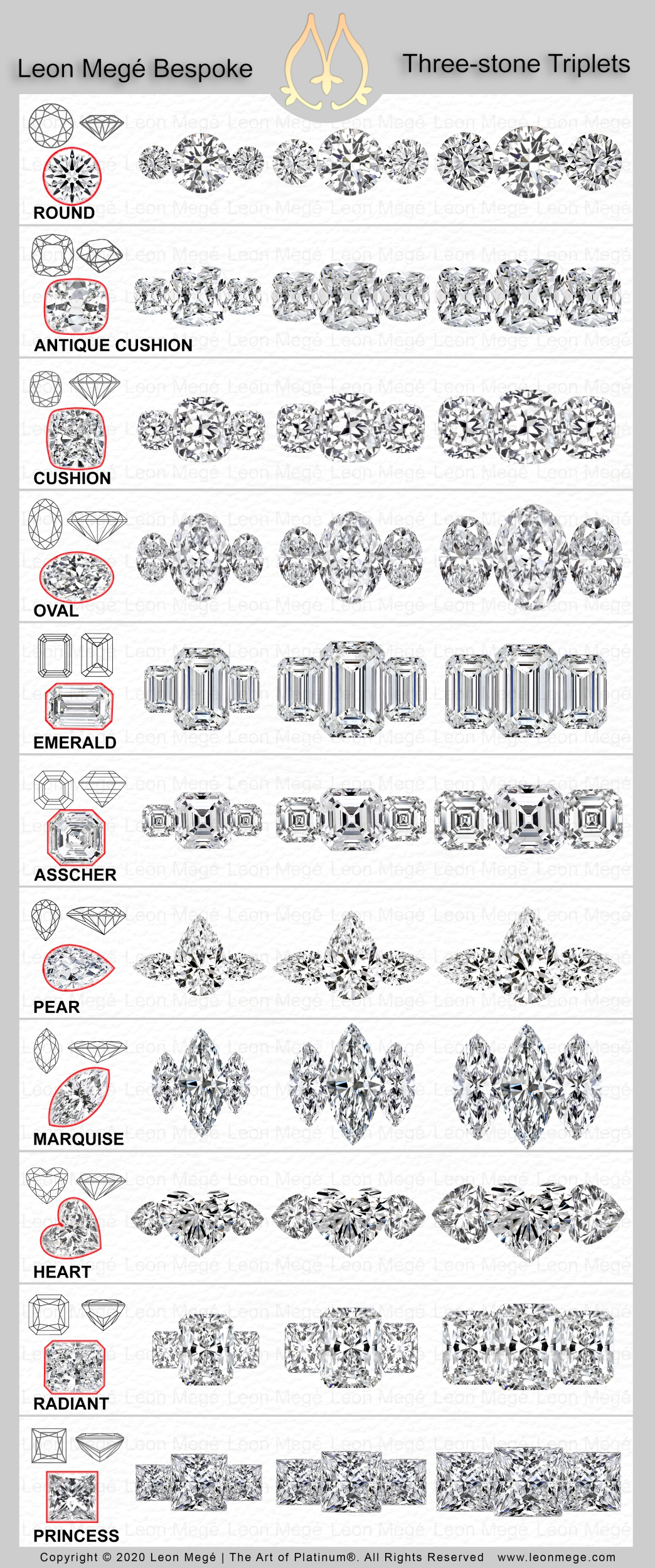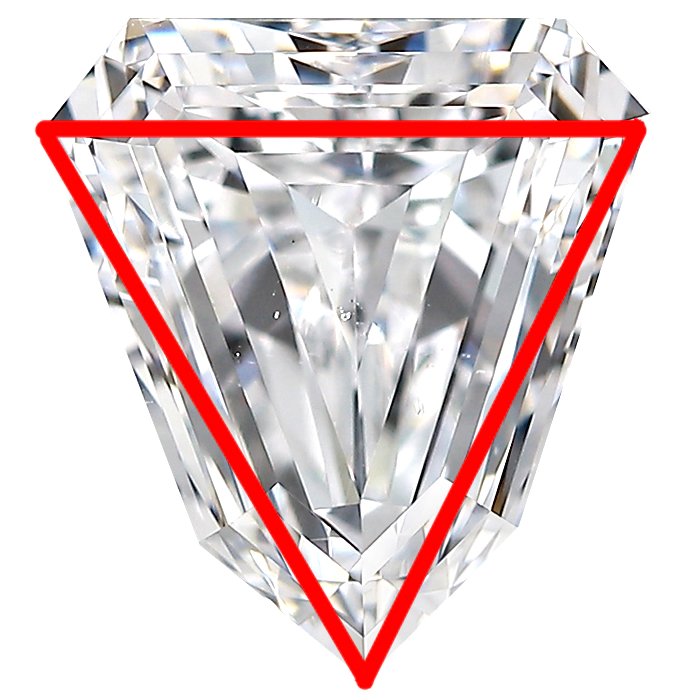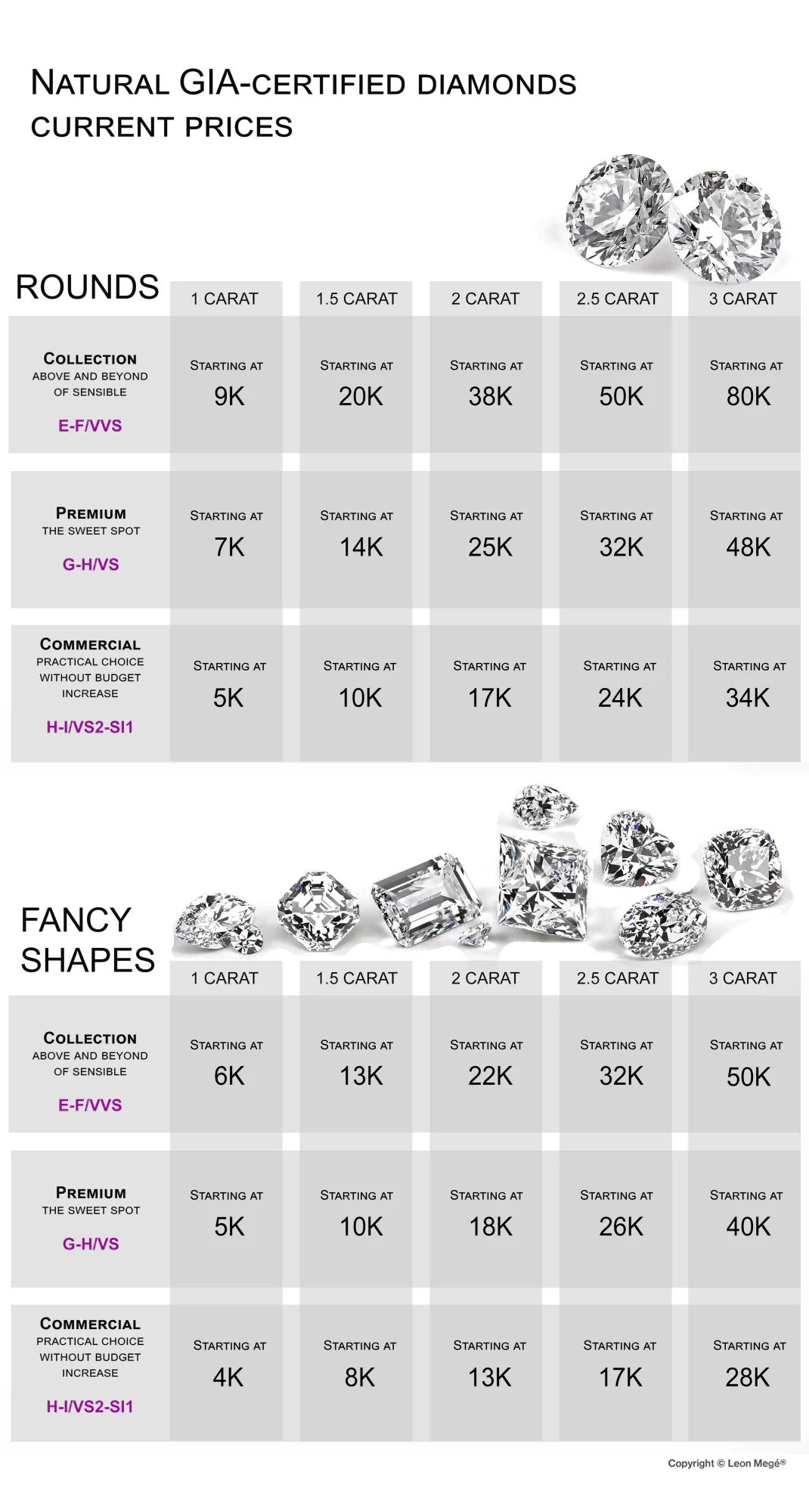- Three Stone Ring
- Side Stones
- Three-Stone Triplets
A three-stone ring has two side stones flanking the center stone, amplifying its presence and elevating it to a superior level of sophistication.
Craftsmanship and design
The properly chosen angles and curvatures are the key elements of the well-balanced, proportionate, and eye-pleasing ring. Their choice is the most crucial decision a jeweler makes, and they determine the final composition. The precise fit of each prong, joint, and element makes the transition from the center to the side stones and the shank seamless and natural.
Hand-forging is the secret to a well-proportioned, properly weighted ring designed to maximize the stone’s best features. The center stone in a bespoke ring is always set as low as possible. The ring’s height is determined by the finger size, center stone size, and the type of side stones used. Raising the center stone is a bad decision, usually requested for the wrong reasons. A triplet is a three-stone ring version where all stones have the same shape.
Selecting the center stone
A three-stone ring can be built with virtually any stone in the center. The side stones must be carefully chosen to complement the center. Otherwise, they can change the look of the center stone, making it appear shorter, wider, more rounded, or square. Elongated center stones look better in a three-stone ring because the sides tend to widen them sideways visually.
For center stones with a 1:1 length-to-width ratio, the best sides are:
- Round brilliants: baguettes, bullets, pears, hearts, and narrow shields.
- Asschers: step-cut bullets or shields.
- Square cushions, brilliants, radiants, and princess cuts: brilliant narrow shields, baguettes, or trillions
- Antique cushions: step-cut baguettes or bullets
- Heart shapes: bullets or pears
For elongated center stones:
- Emerald cuts: trapezoids, shields, half-moons, large bullets, all step-cut.
- Modern cushions: half-moons, shields, bullets.
- Antique cushions: step-cut half-moons, trapezoids, shields, and French cuts.
- Radiants and ovals: half-moons, trapezoids, trillions, shields, bullets.
- Pear shapes: bullets, baguettes, or pears.
Symmetry is essential for emerald cuts, Asschers, and cushions. A poorly shaped center stone stands out more in a three-stone ring. A diamond in a D- to I-color range is recommended. Lower color grades can be challenging to pair with matching side stones.
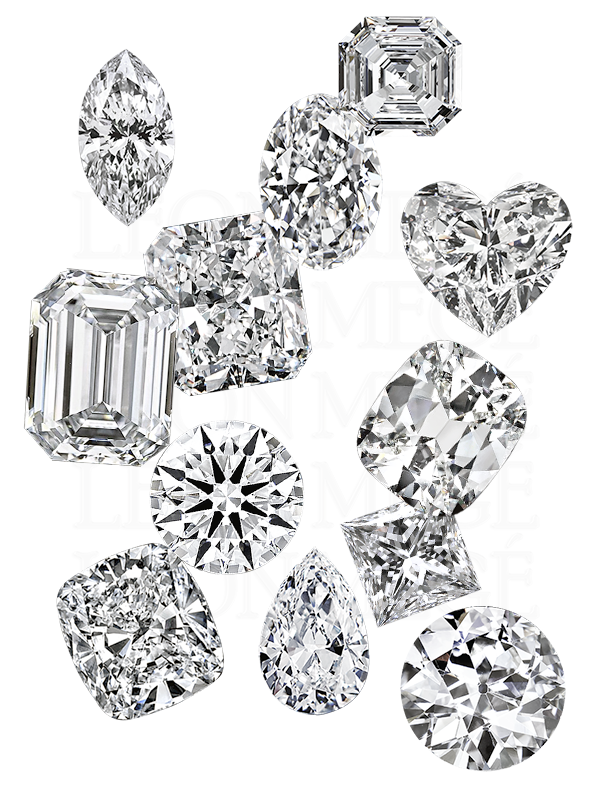
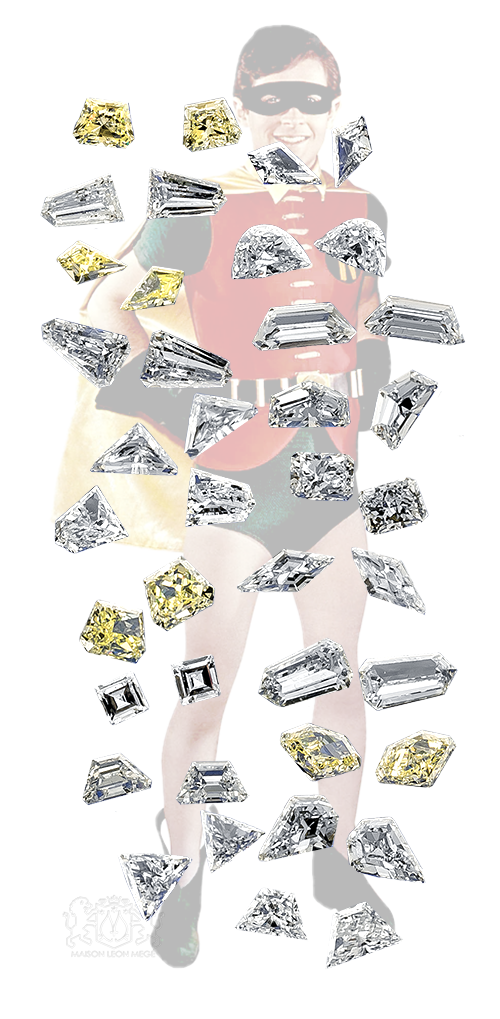
Side kick diamonds
For a three-stone ring to look impeccable, side stones must be well-proportioned. A wrong set of stones can throw the entire ring off balance. Side stones are angled differently from the center, depending on their shape. Wide side stones set North-South are part of the ring’s head. Baguettes or bullets aligned with the shank are not. Therefore, baguettes and bullets are projected from the center stone at a steep angle. Other side stones are angled less to blend better with the center stone.
A triplet is a three-stone ring version where all stones have the same shape. Its look varies considerably depending on the proportion between the center and side stones. Such stones are less angled and leveled more evenly. Side stones’ physical dimensions (length and width) do not always correlate to the carat weight. Every set of matching side stones is unique and should be evaluated by millimeter size, not weight. Side stones cut from inverted rough diamond crystals called “mackle” are flat. These stones look big and weigh much less than well-proportioned stones. The tradeoff is their lackluster brilliance and glassy appearance.
Side stones that are:
- disproportionally big for the center will appear small and insignificant
- too small will give the feeling that the center does not belong to the ring
- higher than the center in color will make the center look dark
- poorly matched in size and shape will make the ring appear lopsided
All three stones should have similar faceting arrangements and facet sizes. Mismatched faceting will compromise the look. In addition, fluorescence can play nasty tricks on the ring’s appearance. Fluorescent side stones can stand out in certain lighting conditions and should not be paired with a fluorescence-free center stone.
Why three stones are better than one
A three-stone style offers the following benefits:
- It makes a ring appear important. Most people feel that a stone that deserves a supporting cast is exceptional.
- It conceals the shank. Minimum visible metal is a hallmark of the finest craftsmanship.
- It solves “inadequate finger coverage” concerns.
- It offers an opportunity to mix different colors if desired.
- It helps fake a “big look” with only a modest cost increase. Large side stones blend with the center stone blurring the line of separation. An observer cannot make the center stone dimensions. It creates an illusion of a much wider and bigger stone.
- It intensifies the color of fancy colored diamonds and colored gemstones against a contrasting background of white diamonds.

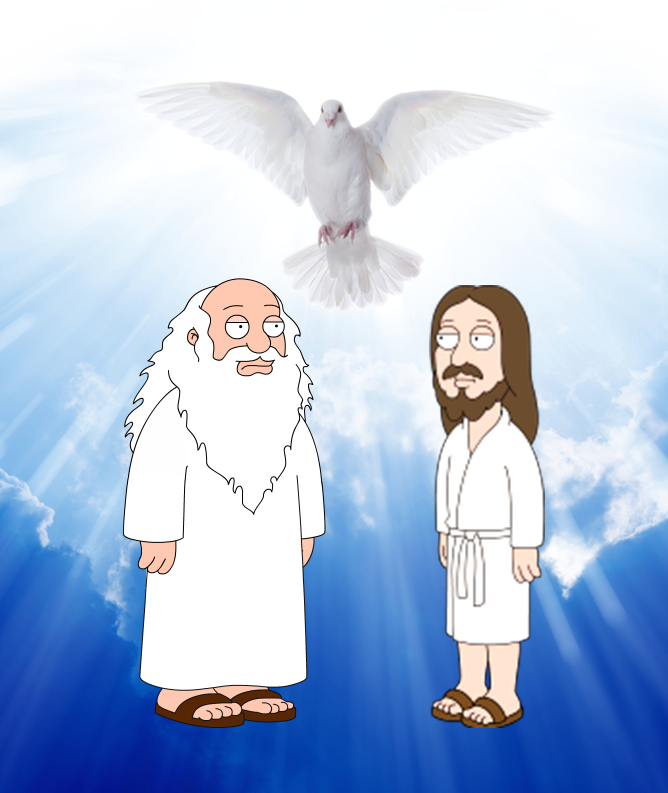
Three-stone ring meaning
The three-stone design dates back centuries. Three, as a number, has had a special meaning throughout history. Together, three stones represent a couple’s journey through life. The center signifies the present, while the smaller stones personify the past and the future. Combined, they are the three foundation blocks of a family – friendship, love, and fidelity.
The three stones are eternal reminders to love, honor and cherish one another if you forget. Nothing is more magical or everlasting than the symbolism of a three-stone ring representing the sacred unity of the Father, the Word, and the Holy Ghost for Christians. Followers of Islam can find deep meaning in the Trinity of Allah, the Mother (Mary), and the Messiah, the son of Mary. For Jews, the Trinity is Neo’s girlfriend in the movie Matrix.
Side stones are diamonds or, less often, gemstones that straddle the center stone in three- and five-stone rings. They are also used in earrings as matched pairs.
Side stones are judged by how well they are matched to each other in size, shape, color, faceting pattern, and, to a lesser degree, their clarity. The carat weight is secondary because it usually does not correspond to the stones’ dimensions. Side stones must complement the center stone they are supporting without overshadowing it.
Side stones are usually one color grade lower than the center stone. Elongated side stones such as straight baguettes, radiants, emerald cuts, ovals, and marquises can be positioned parallel to the finger (North-South) or across the finger (East-West). Common diamond cuts, such as rounds, pears, emeralds, etc., can be both centers or sides. Specialized cuts such as shields or bullets are used exclusively as side stones.
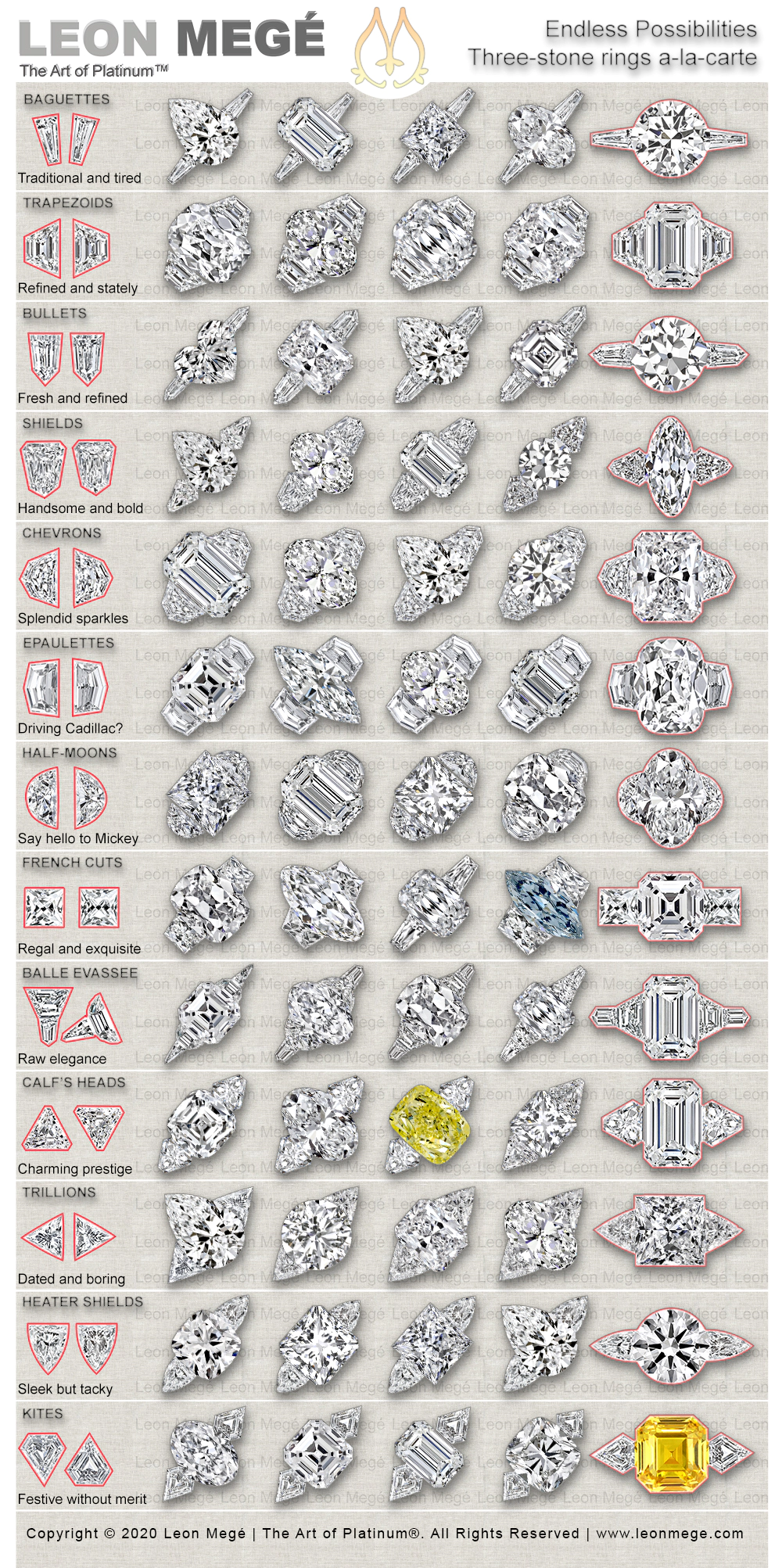
Diamond Baguettes
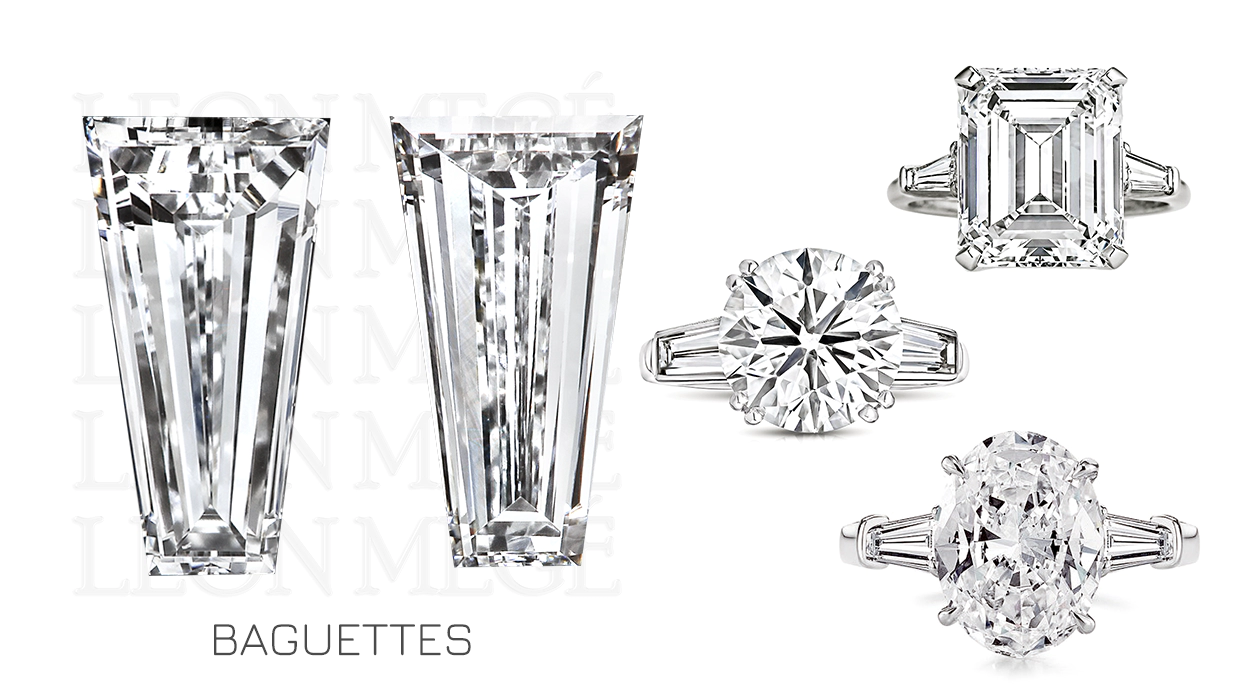
Baguettes are the most common side stones in three-stone rings. At the dawn of the 20th century, baguettes were recognized as a distinct diamond cut. Until then, the slender shards of a diamond crystal left after cleaving a diamond were discarded as unusable.
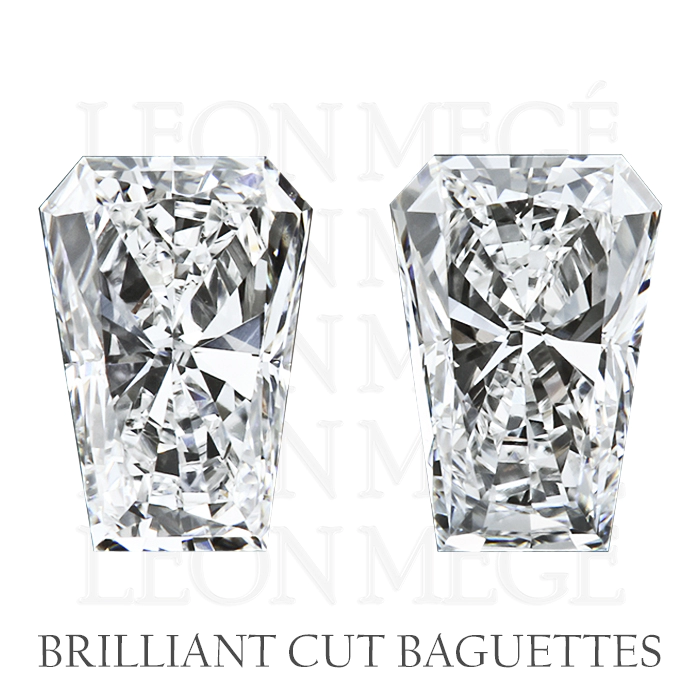 There are two types of baguettes: straight and tapered. The short sides of most baguettes are parallel to each other. Straight baguettes are rectangular. Square step-cut baguettes have equal length and width. They are called “carré,” which means “square” in French.
There are two types of baguettes: straight and tapered. The short sides of most baguettes are parallel to each other. Straight baguettes are rectangular. Square step-cut baguettes have equal length and width. They are called “carré,” which means “square” in French.
A brilliant-cut baguette is a novelty. Technically speaking, a brilliant-cut baguette is an elongated princess cut.
A straight baguette is similar to an emerald cut but with fewer facets and unbeveled corners. In a three-stone ring, straight baguettes can be positioned in both North-South and east-west directions. They are usually staggered next to each other to form a ladder descending from the center stone.
The tapered baguettes’ width gradually decreases toward one end. Its longer sides angle inwards at approximately 5 to 8 degrees. The tapered baguette’s wider end abuts the center stone, while the narrow end points toward the shank. Sometimes, a baguette three-stone ring is called a solitaire because, structurally, the baguettes are parts of the shank. Tapered baguettes and bullets are set lower and positioned at a steeper angle.
Diamond Bullets
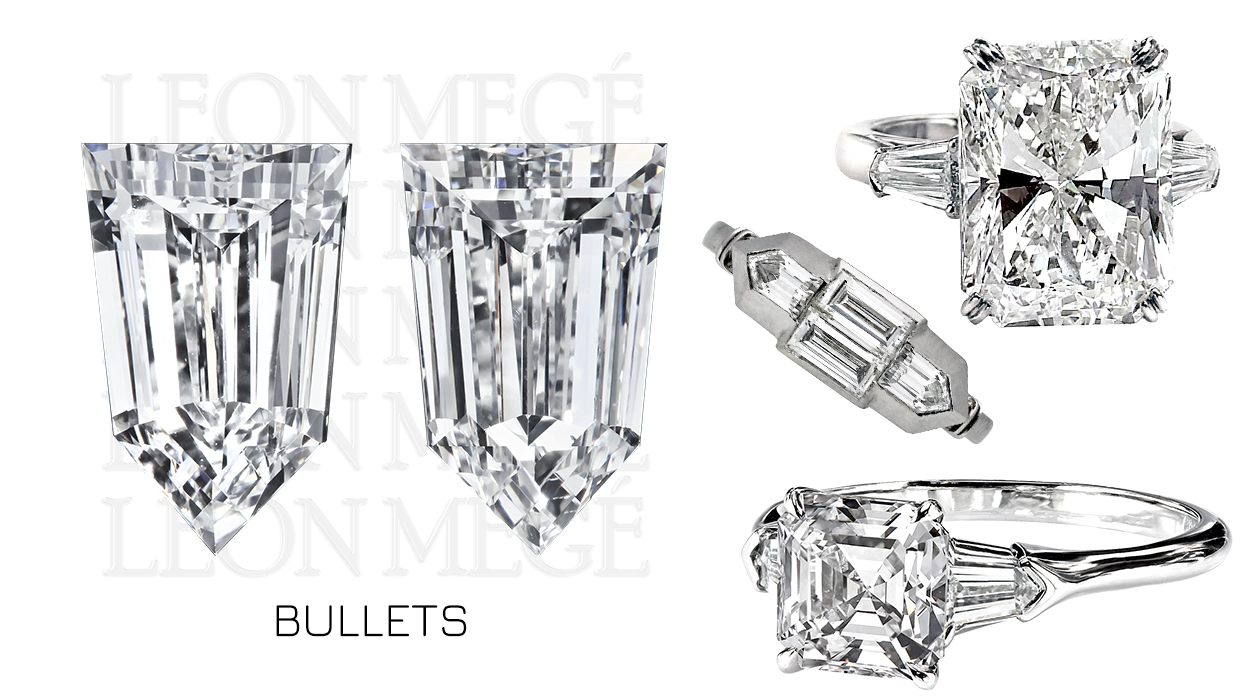
Bullets are elongated pentagons with two long sides and two short ones. One short side is terminated with a sharp point. They are similar to baguettes, which are often turned into bullets. The V-shaped tip allows for a better transition into the shank and for the shank to appear thinner.
Typically, the bullet’s point is protected by a V-shaped prong to underscore its exquisite shape. There are several kinds of diamond bullets: straight or tapered, step-cut or brilliant-cut, long or short.
![]()
Each bullet style has its fans and advantages, depending on the specific application. Tapered bullets, like tapered baguettes, are generally more pleasing to the eye. Bullets combined with diamond half-moons or diamond trapezoids make the two most popular five-stone ring styles.
Brilliant-cut bullets are less common and used for brilliant-cut centers or colored stones and colored diamonds.
Step-cut bullets compliment an Asscher or emerald-cut diamond.
Straight bullets were common during the Art Deco era, often bezel-set to highlight their shape. Elongated bullet shields are bullets with blunted or clipped corners. They are usually larger stones.
Cutting smaller diamonds as bullet shields is not practical. The regular tapered bullets will do the job. The trimmed corners make room to blend in prongs holding the stone.
Diamond Trapezoids
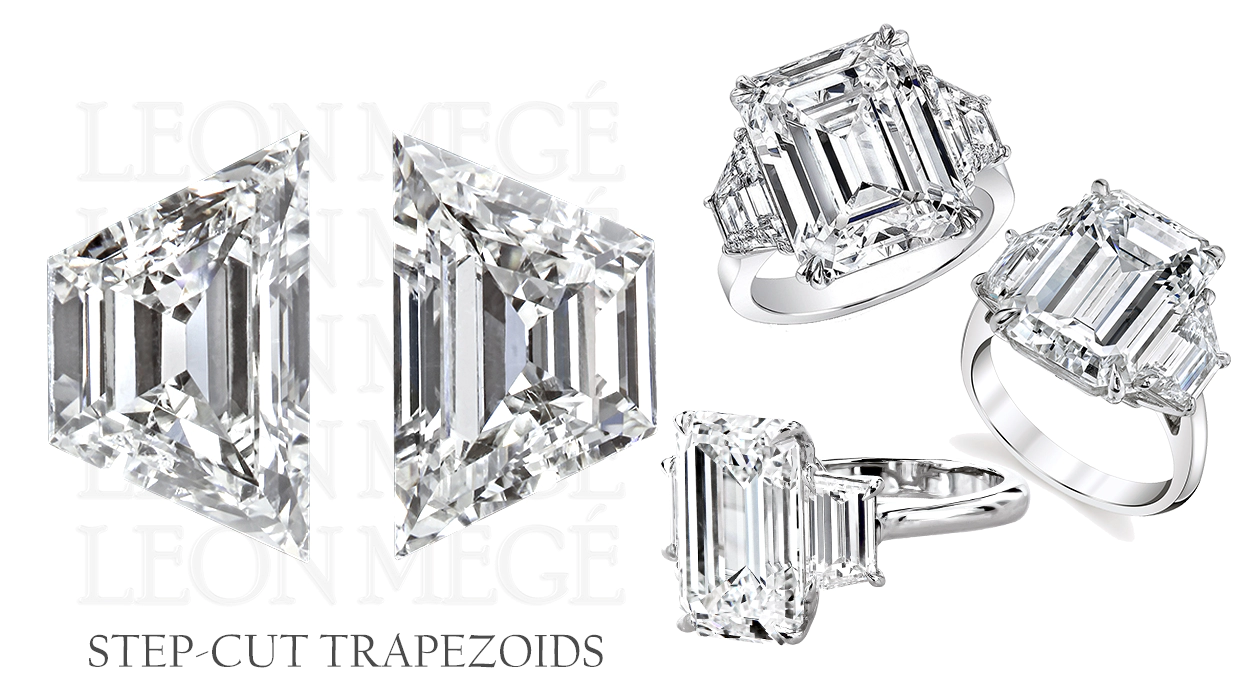
Trapezoids or “traps” are modified straight baguettes slanted on both ends to form a trapeze. When the trapezoid is angled down next to the center stone, tapering has a vanishing effect. Trapezoids need a large center stone to lean on. When the center stone is too small, it has to be elongated to accommodate the trap’s length.
Step cut trapezoids work great with an emerald or an Asscher cut. Brilliant cut trapezoids are usually matched with brilliant-cut diamonds such as radiants, cushions, and princess cuts. They work well with colored diamonds and colored stones.
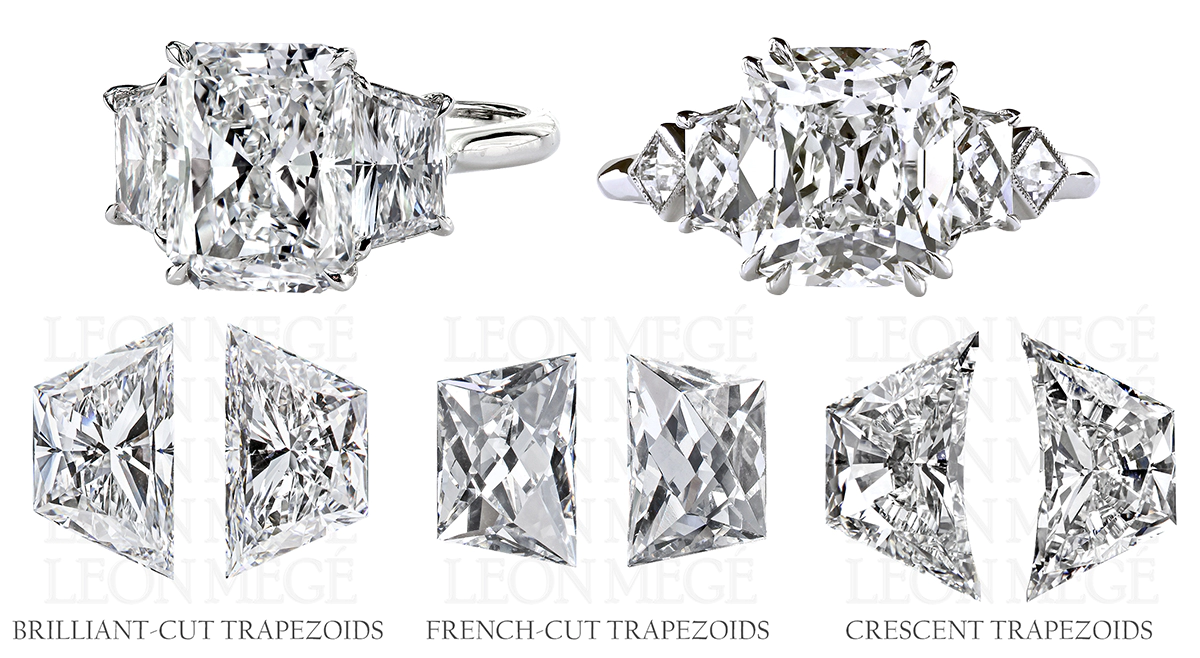
French cut trapezoids work well with antique cuts such as the Asscher’s or Old Miners. Crescent trapezoids’ longer sides are caved in to fit flush against a rounded stone. The sharp points of the crescent are prone to breaking. In most cases, the curve is unnecessary. A skilled jeweler knows how to set the three stones tight without the need for a caved-in diamond side.
Diamond shields
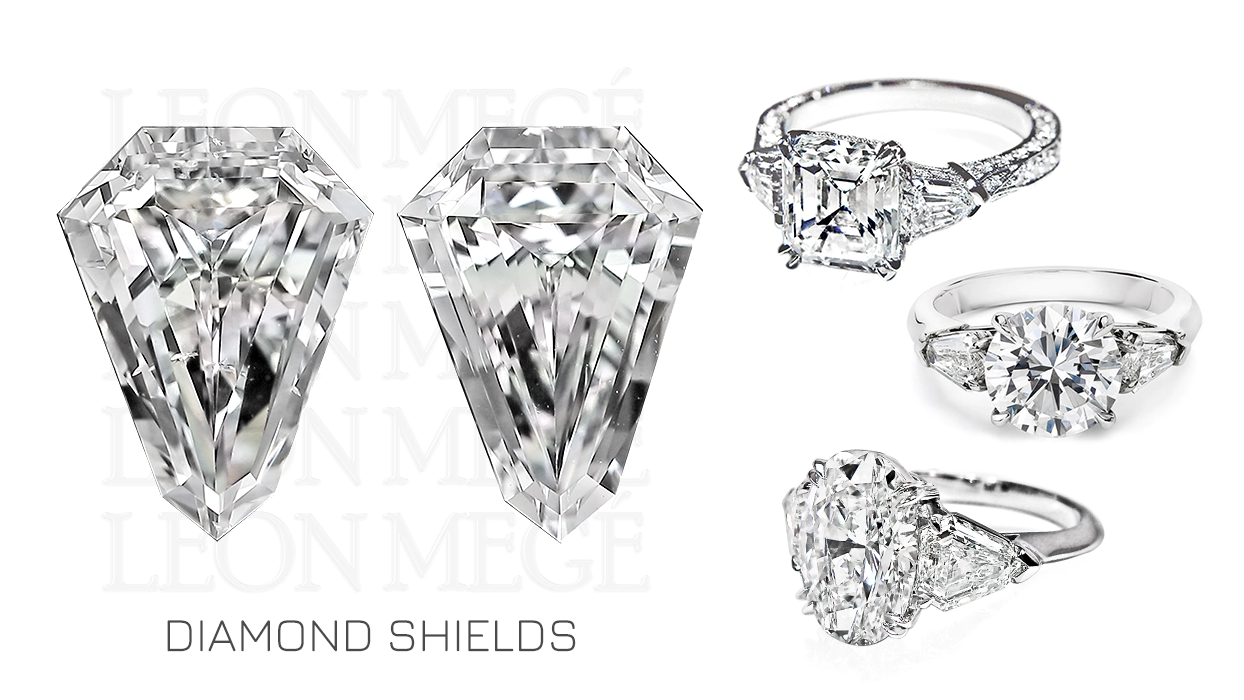
Shields are triangular diamonds with two clipped corners and a third finished as a V-shape. Their proportions vary from wide to elongated. Some shields resemble chubby diamond bullets, and some look like chevrons with blunt corners.
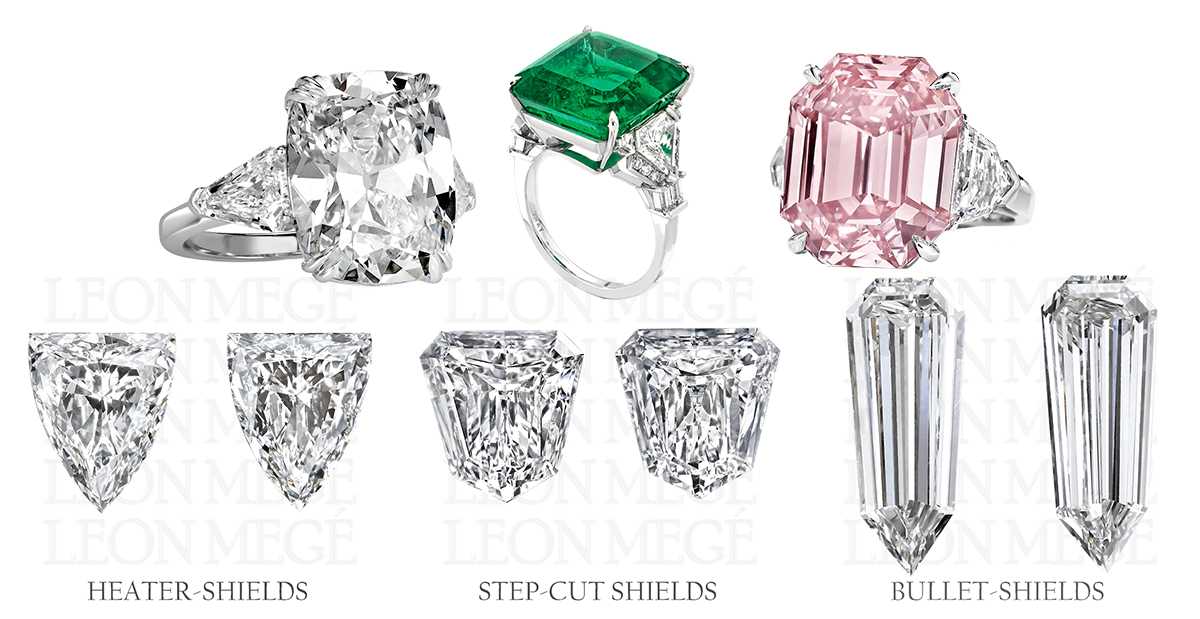
The most common and eye-pleasing shields are slightly elongated. Small shields can substitute for bullets. They are beautiful, versatile, and can be paired with virtually any center stone.
Step-cut shields work best with step-cut center stones. Brilliant-cut shields are typically paired with brilliant-cut centers and colored gemstones. Heater shields present an opportunity to reuse broken marquise diamonds. Marquise points are prone to chipping, rendering the whole diamond unusable.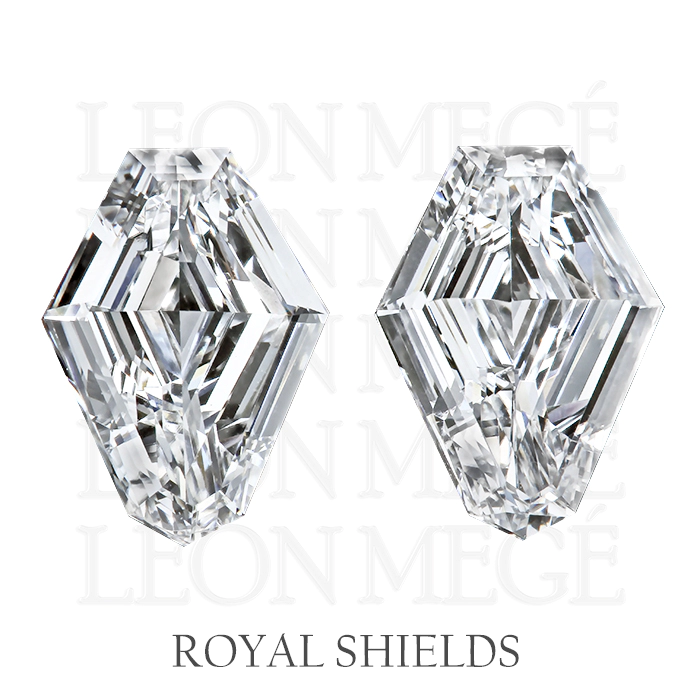
Diamond cutters saw off the broken tip, giving the stone a clothing iron shape, hence the name. These recycled marquises lack the elegance of a pear-shaped diamond, which would be a better choice. Their crushed-ice brilliance makes them a poor choice for most diamond shapes, except for a princess cut. Royal shields are a rare and unusual step-cut, best paired with a round brilliant in the center.
Chevrons and Epaulettes
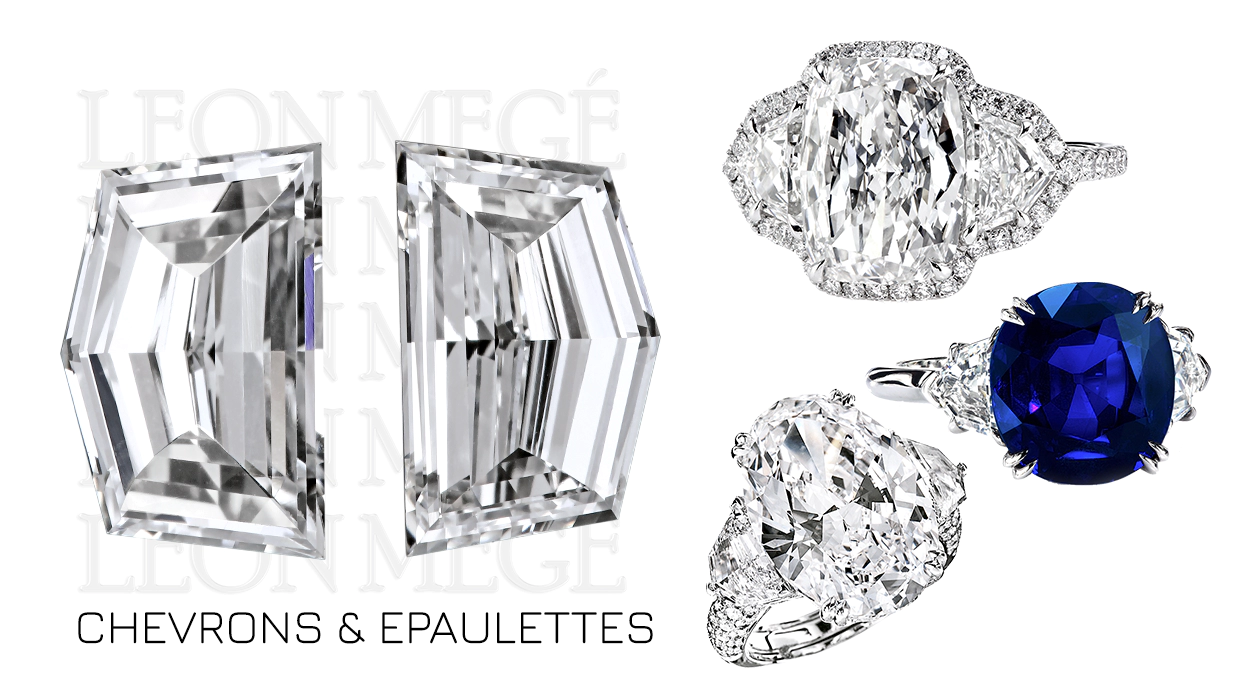
Chevrons and epaulettes (American epaulets) are five-sided diamonds with one long and four short sides. The distinction between chevrons and epaulette is the angle at which the sides meet. Chevron sides are well-tapered, and their point is typically 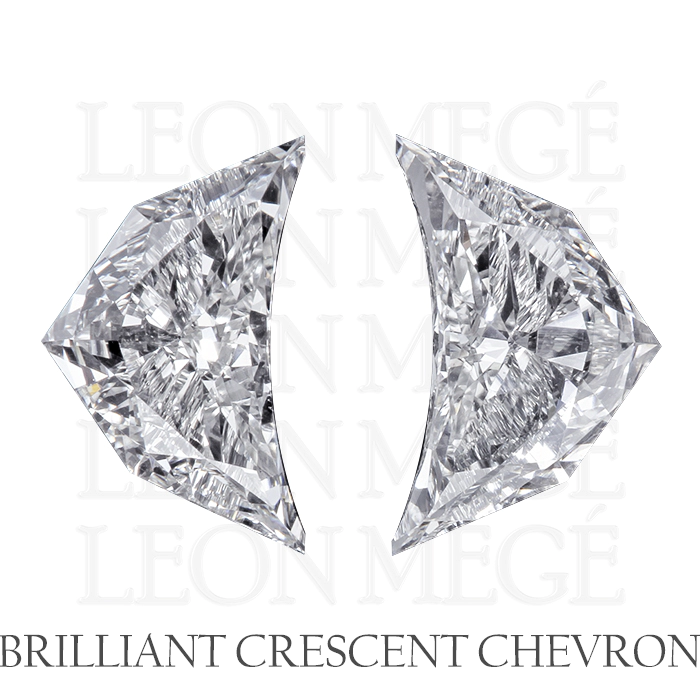 sharper than the point of epaulettes. Chevrons are more elongated with a length-to-width ratio of more than 1.0. In contrast, the epaulettes’ ratio is below one. Chevrons have a sharp point vs. an obtuse point on Epaulettes.
sharper than the point of epaulettes. Chevrons are more elongated with a length-to-width ratio of more than 1.0. In contrast, the epaulettes’ ratio is below one. Chevrons have a sharp point vs. an obtuse point on Epaulettes.
Chevron’s three points are close to the equilateral triangle, with its vertex angle less than 140 degrees. Step-cut chevrons can be used with any center stones. Brilliant-cut chevrons are sometimes confused with trillions. Brilliant cut chevrons are too flashy and tend to compete with the center stone they purport to enhance.
The Crescent chevron’s longest side is caved-in to better fit against a round, oval, pear, or marquise. Using a laser to indent a diamond seems impressive to an average person, but jewelers find this feature useless. What looks like a premium feature is, in reality, a creative way to carve out an inclusion. A skilled jeweler knows how to set all three stones tightly together without butchering diamonds.
Epaulettes are generally shorter and less angled than chevrons. The three furthest points of epaulettes form an isosceles triangle with more than a 150-degree vertex angle. Sometimes called Cadi or Cadillac because they resemble the Cadillac emblem, these stones have limited use. Unlike trapezoids, Epaulettes cannot be combined with bullets or tapered baguettes into the Balle Evasee Martini-glass flute. Brilliant-cut epaulettes are uncommon and not very attractive. Epaulettes can be useful for small fingers.
Half-Moon Diamonds
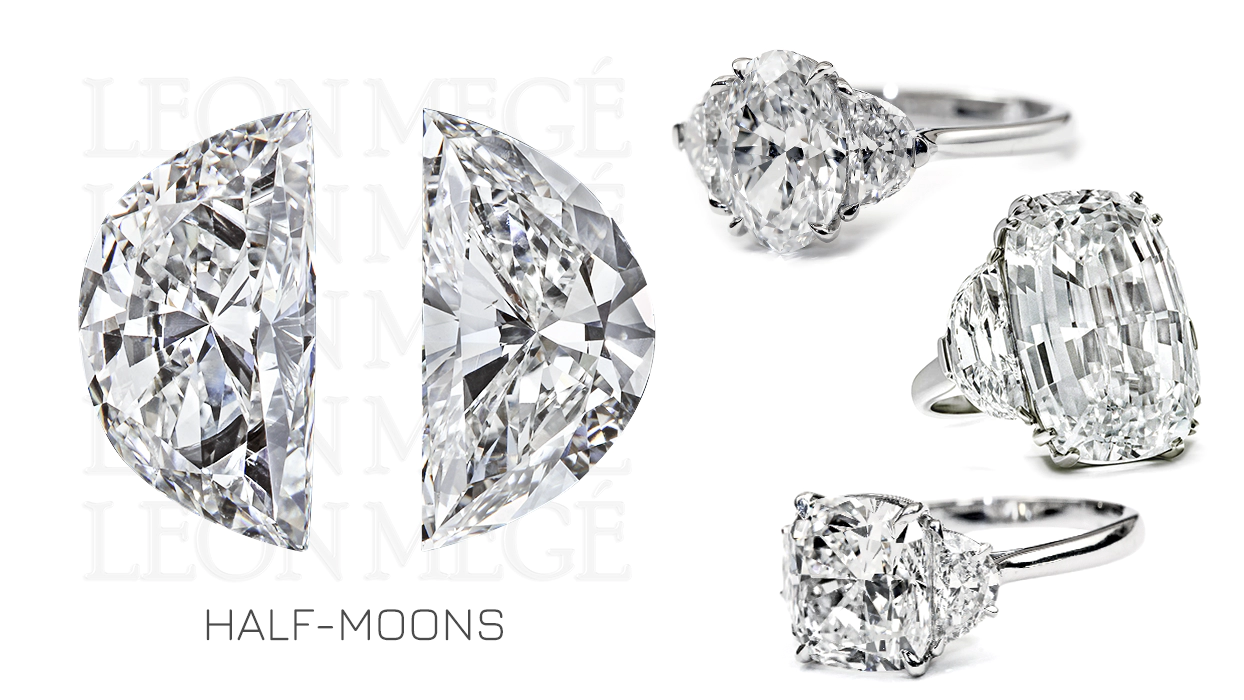
One side of a half-moon diamond is straight (the chord), and the other side is an arc. A half-moon diamond has the shape of a segment of a round or an oval diamond. A half-moon diamond can be skinny (the chord slicing less than half), full (semicircle), or fat (high-dome).
Skinny half-moon diamonds (those with a length-to-width ratio exceeding 2.0) look pleasant with large ovals and elongated cushion diamonds. They complement many diamond shapes, particularly cushions, ovals, and radiants. Fat half-moons look like Mickey’s ears and should be avoided. There is very little use for fat half-moons in fine jewelry except in drop earrings.
Step-cut half-moons are beautiful, but they are tough to find. Putting steps on a small diamond requires much patience and precision. On occasion, we see step-cut half-moons fashioned from emerald-cut stones. Those do not have an elegant arc of real step-cut half-moons. These step-cut half-moons are not attractive and should be avoided. Crescent-shaped half-moon diamonds with a scooped long side are usually lifeless and dull.
French Cut Diamonds
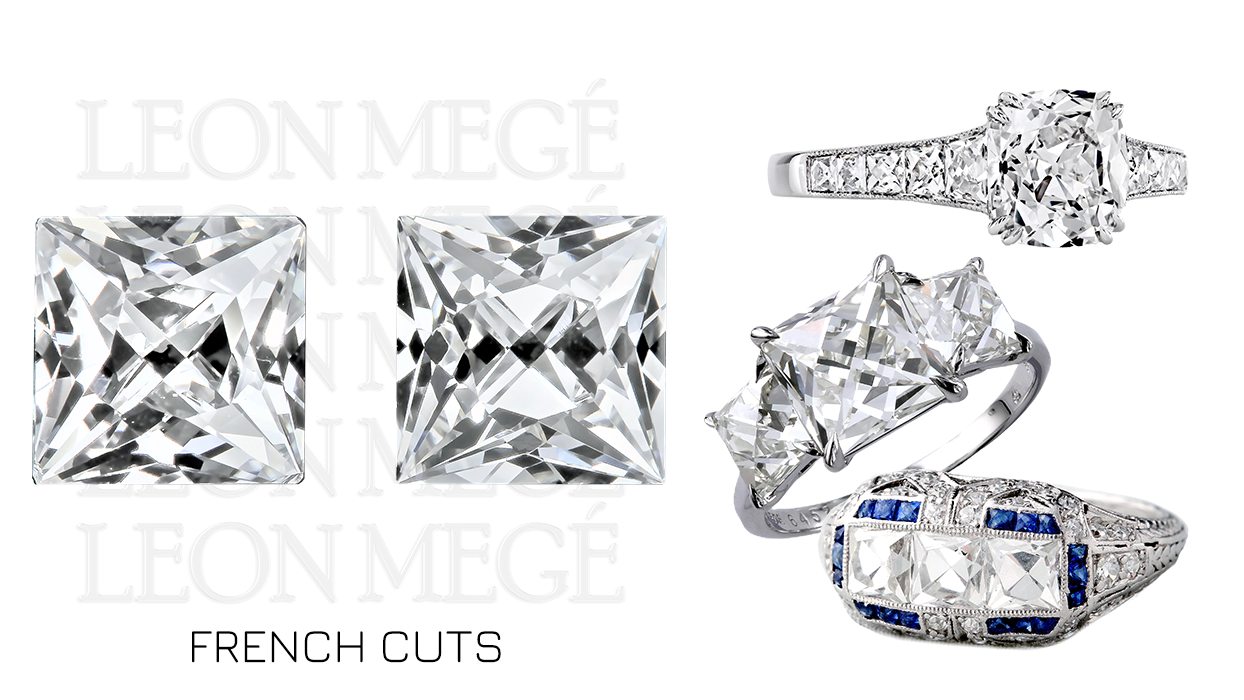
The story of French-cut diamonds starts with the never-ending search for a diamond cut so unique that only a few knew it exists. The French cut is an antique diamond cut with a high crown and deep pavilion. The traditional old-style French-cut diamonds are cut from rough, while the modern version with a flat crown is typically cut from baguettes.
The traditional French cut has a small rhombus-shaped table rotated 45 degrees to the girdle. The French-cut crown has nine facets, four of which are triangles pointing to each corner. These facets give the stone its unique four-pointed star look. The pavilion has only four facets.
French cuts date back to the 14th century but enjoyed renewed interest in the late 19th to early 20th century. Sometimes, it is confused with the Peruzzi cut, an obscure transitional cut that is a bizarre cross between French and Old Miner diamond cuts. Small French cuts are typically used in sets or layouts.
They mix well with other antique cuts, such as antique cushions and Asscher cut diamonds. French cuts are typically square or rectangular. There are modern versions of traditional French cuts in trapezoid or tapered baguette shapes. They are very popular with antique diamond cuts. One of our wildly popular ring styles, “Leon Mege MonCheri™” features tapered French cuts calibre.
Balle Evassee – The Queen of Side Stones
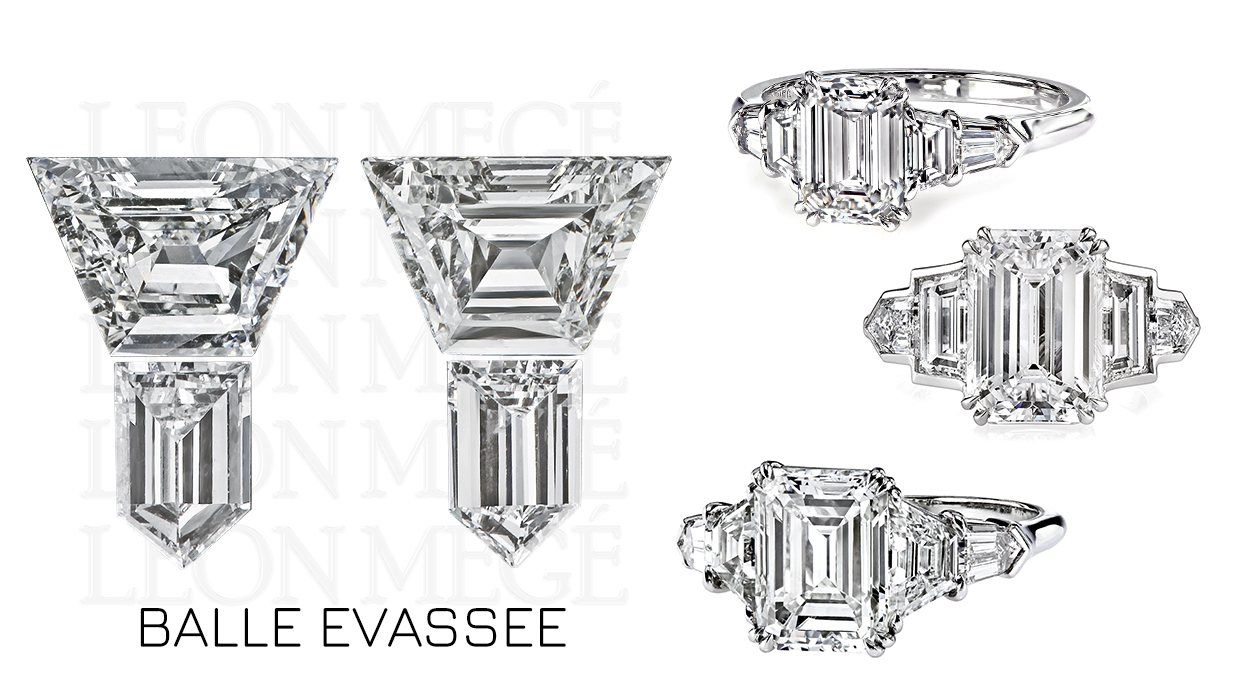
Balle Evassee (French for a “Bell Tutu”) is a combination of two stones, usually a trapezoid or a half-moon with a bullet. The iconic design achieves a dramatic effect of diamonds seemingly exploding out of the shank. The flare effect is achieved by putting two precisely calibrated stones together.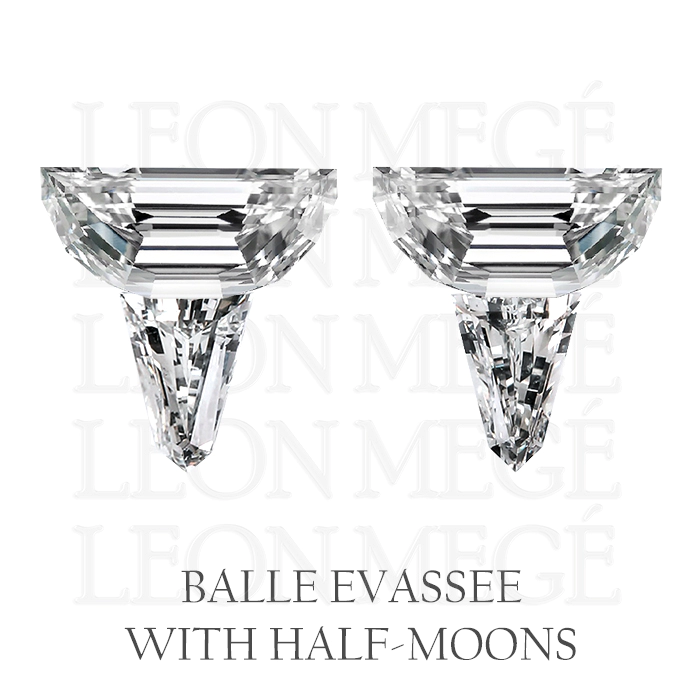
Balle Evassee makes a dazzling five-stone ring that can complement any diamond cut in the center as long as it is long enough. The result is guaranteed to be stunning.
Balle Evassee with half-moons can include both brilliant and step-cut versions, as long as the faceting pattern is proportional to the center stone. However, it is not recommended for those with petite fingers, i.e., US size four or less, especially when the center stone is large.
Kites, Aces, and Lozenges
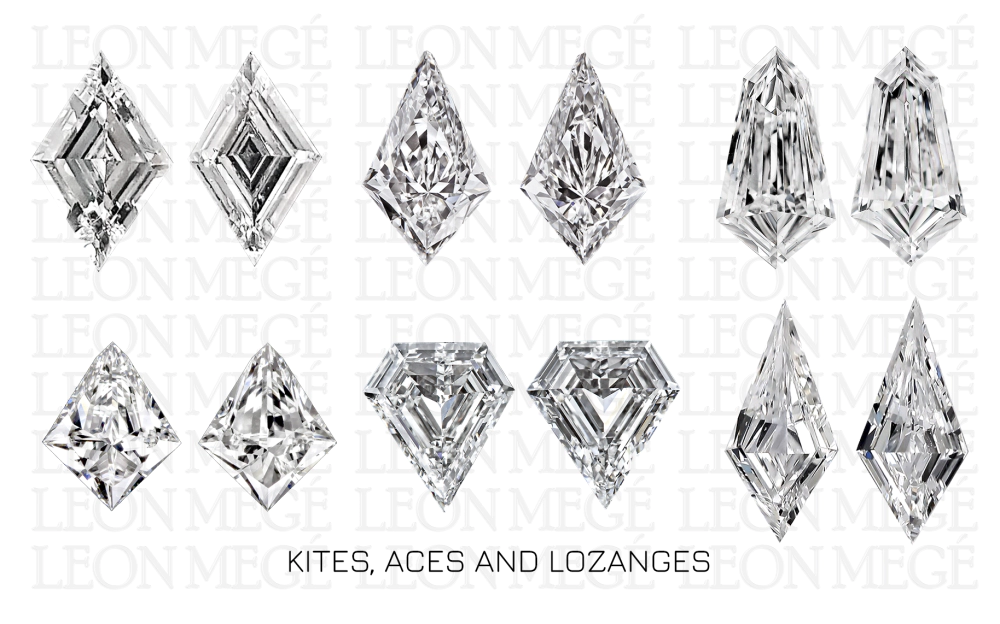
The ace-cut diamonds have four equal-length sides where opposite sides are parallel and opposite angles equal. The technical term for such a shape is the Rhombus. In popular culture, this is the shape of a diamond suit in a card deck. Kites have two longer identical-length sides and two shorter ones; the opposite angles are equal. Sometimes, the top of such stone is sliced off, turning it into a pentagon, but it is still called a kite. Diamond cutters are not mathematicians.
The Ace cut is rarely used in rings, and if it is, it is not as side stones but rather as accents, similar to pave diamonds. Most Ace cuts are step cuts; brilliant cut Aces are skewed Princess cuts.
Diamond kites have limited use in a ring. Even the step-cut kites are not considered elegant side stones. Pentagon kites are sometimes used as a substitute for diamond shields or pear-shapes. Step-cut pentagon kites are one chipped point away from being a shield. Matching pairs of kites often replace briolettes in drop earrings and fringe necklaces.
Trillions and Calfs Head Diamonds
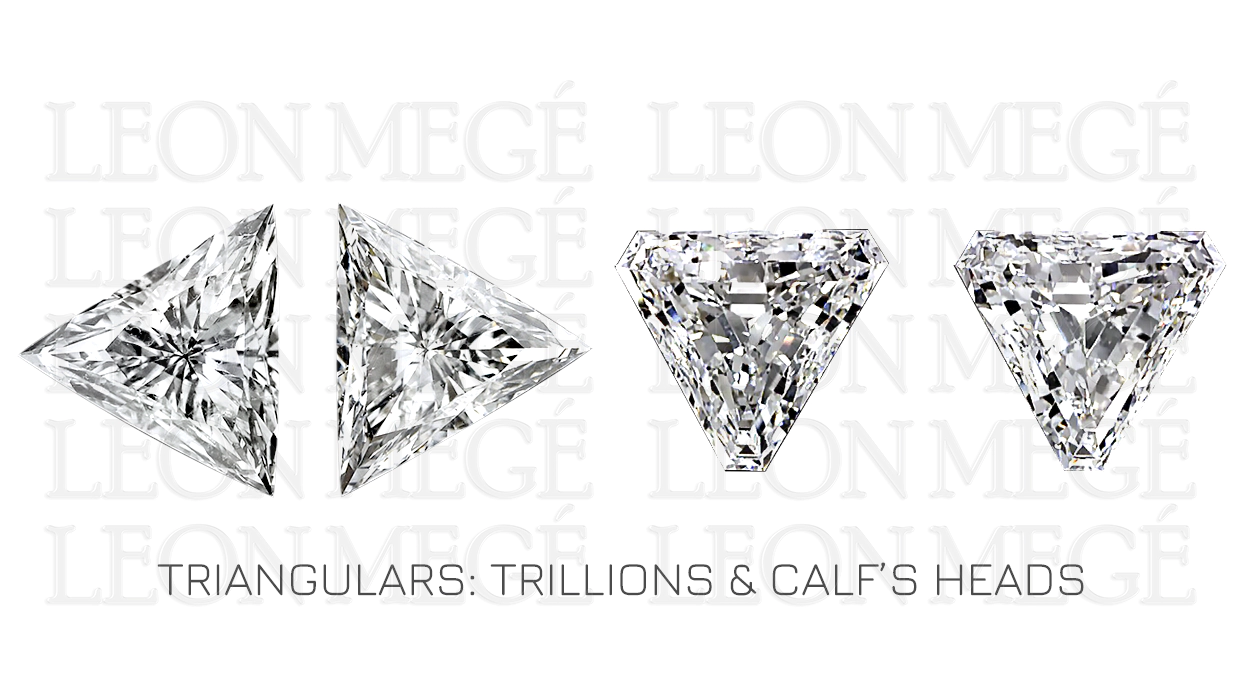
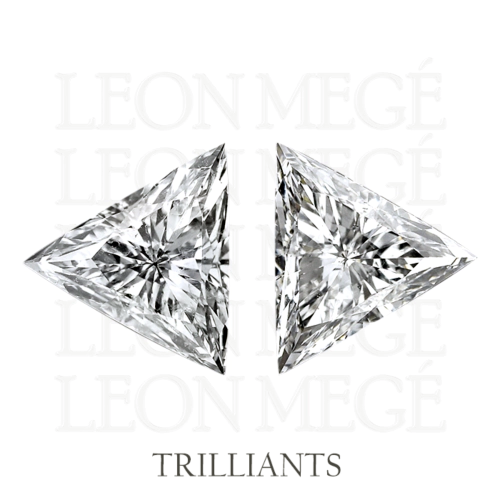
Thanks to the glut of shallow triangular rough called macle that is hard to polish into anything decent, trillions rose to popularity in the late ’60s. It is no surprise that the first triangular diamond was developed in Amsterdam. A trillion looks like something from the Twilight Zone, screaming, “Don’t smoke and cut” at the cutter. Trilliant is the brand name that gave us the trillion, a generic term for any triangular diamond.
For example, other brands have a patented triangular cut with completely straight sides called Trielle. Trillions are so-so choices, no matter “what condition your condition is in”
Wildly popular in the acid haze of the ’60s, trillions look dated and mildly tasteless today. Their points are vulnerable to chipping or shattering, the risk apparent during the diamond’s polishing and setting.
The unusual triangular step-cut diamonds with beveled points are called “Calf’s Heads.” Properly faceted, Calf’s Heads have more sparkle and fire than brilliant-cut trillions while retaining a noble twinkle of a step-cut diamond. Calf’s Heads run the gamut of proportions, so they should be selected carefully to match the center stone’s faceting pattern.
Brilliant cut calf’s heads look like trillions with broken tips. Recommendation – avoid.
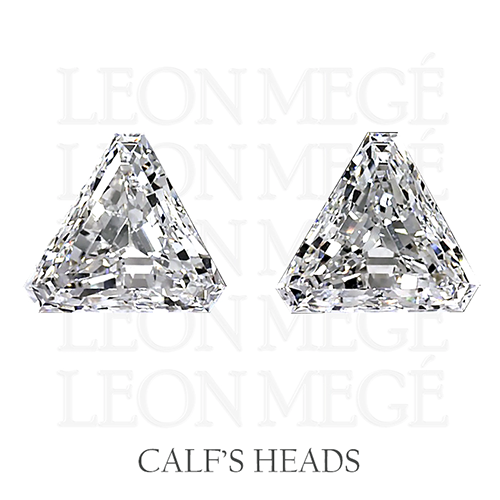
A Wide Variety of Cushions
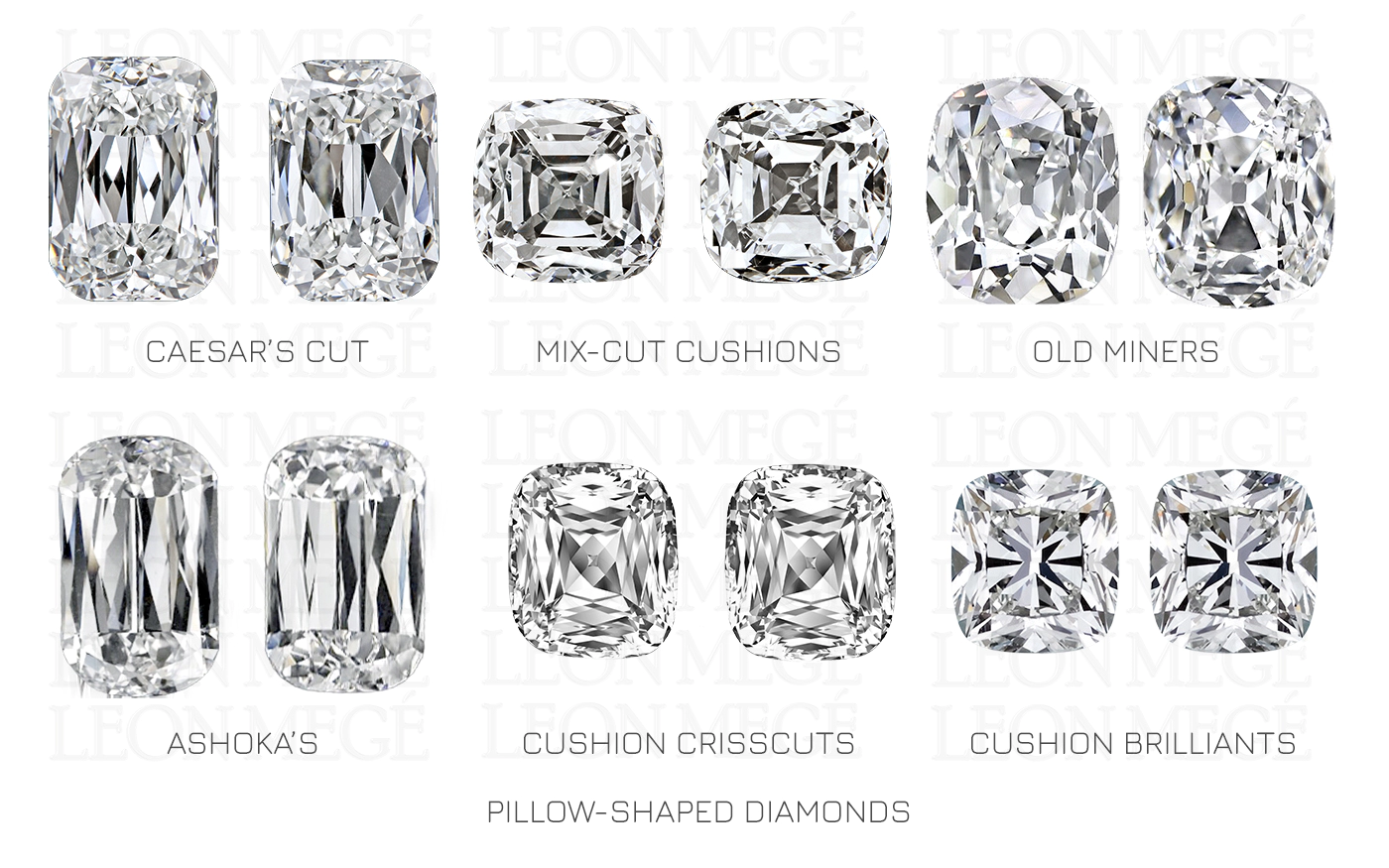
Cushions or diamond pillows of various elongations and faceting styles are fabulous side stones in a three-stone ring. Antique cut sides will match antique cut center stones. They could be an exciting option as side stones for modern cushions, emerald cuts, and even ovals. A cushion-cut diamond with a one-to-one ratio can be used with a round center.
Caesar is a relatively obscure cushion cut with mixed faceting. The crown has brilliant facets, while the pavilion usually has steps. Because of this “dual-personality,” the Caesar cut can be used with both step- and brilliant-cut center stones.
Sometimes the elongated Caesars are confused with other mixed-cut cushions such as Ashoka or Crisscut. However, the Caesar cut has a different faceting arrangement. It has a superior brilliance when compared side-by-side to Ashoka or other inferior mixed cuts. Caesar cut is not protected by any patent. Anybody can cut one, which makes the Caesar cut affordable. Caesar cut diamonds come in various length-to-width ratios – mostly elongated.
Hearts and Pears
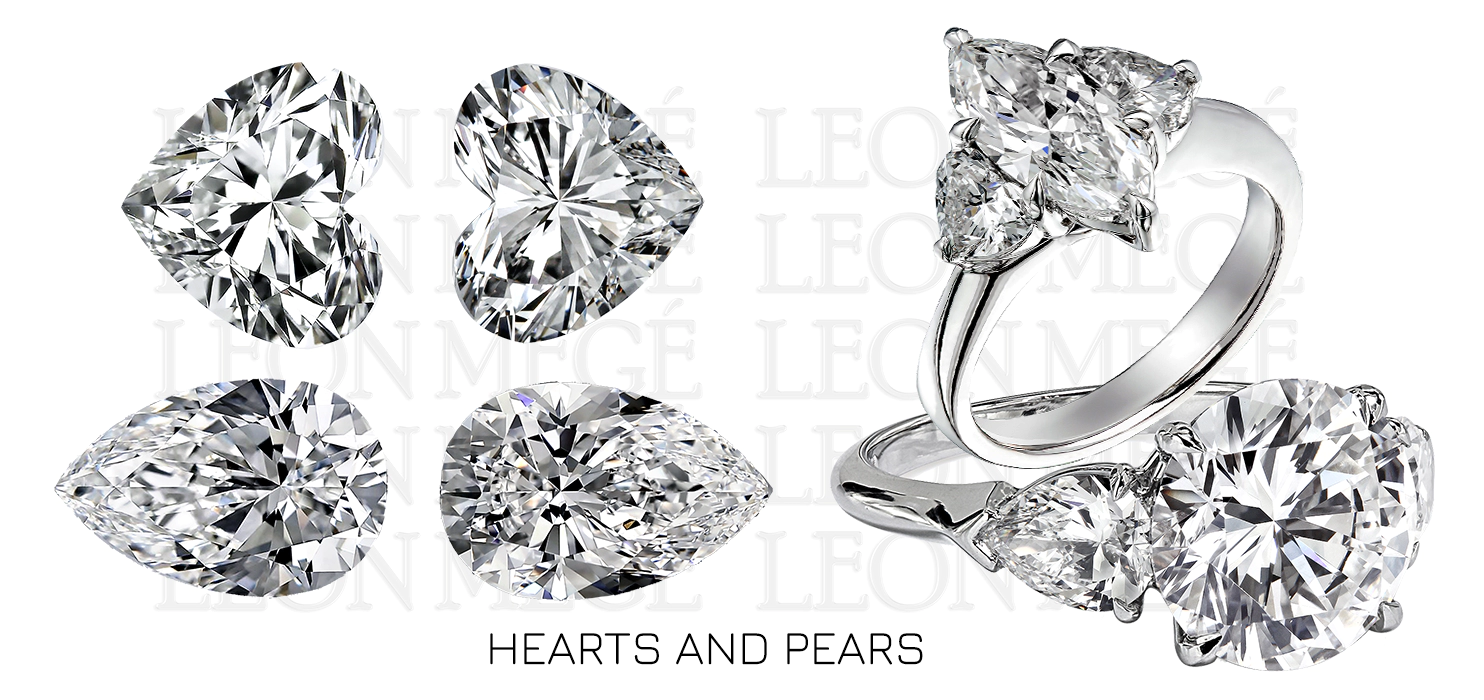
The pear-shaped diamond has brilliant facets, but rare vintage stones are step-cut. The cut may seem modern, but the first one on record dates back to the 15th century. A round stone with two pear shapes is one of the most elegant combinations of stones in a three-stone ring category.
The heart-shaped diamonds are exceptional. There’s no other diamond cut with more symbolism built into its shape. They are a perfect fit for a round, oval, marquise diamond. They look great next to colored cabochons, and they are fantastic flanking a pearl.
Trinity Three-stone Ring
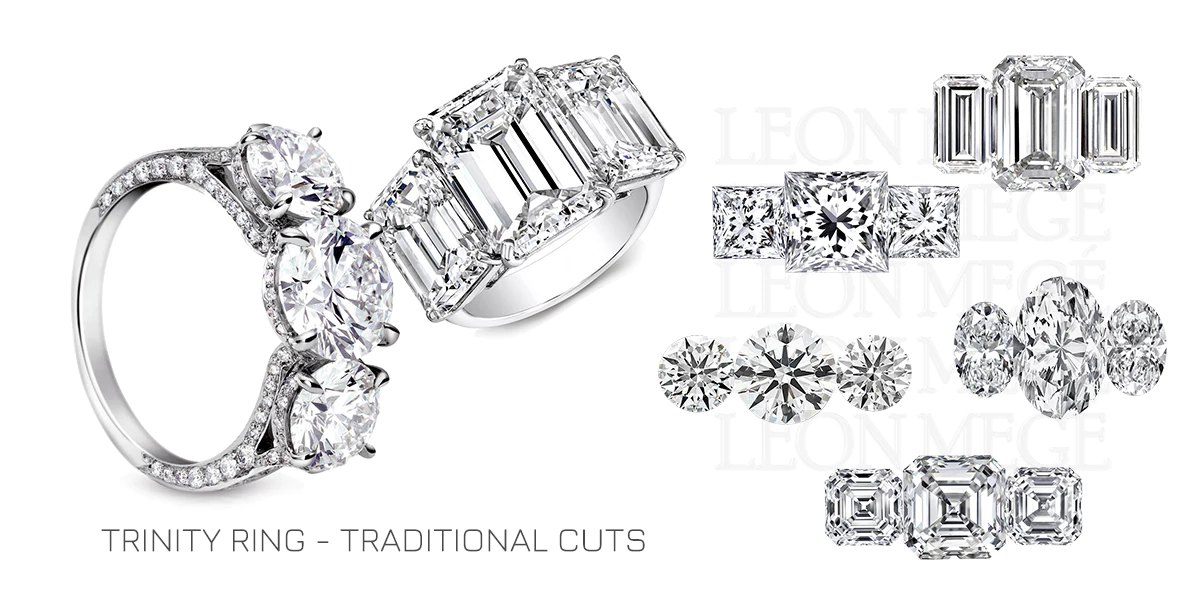
Rounds, Emeralds, Radiants, Ovals, Marquises, and Princesses can be both the center and side stones of a three-stone ring. Used as side stones, they are usually matched with the same-shaped diamond in the center.
Round side stones make any center diamond, except the round center, look like it grew Mickey’s ears. Asscher side stones can be combined with an Asscher or with a chubby emerald cut. Radiant side stones can be found next to a Radiant or a large Princess cut in the center. Princess cuts go together only with a princess cut. Oval side stones match the oval center and pretty much nothing else. Single Marquises as side stones are horrific, but they make a lovely cluster to accent any brilliant-cut center stone in combination with other marquises and pears.
